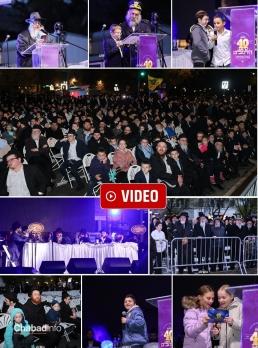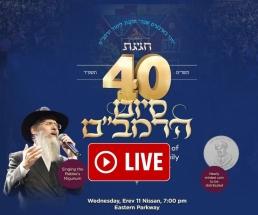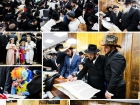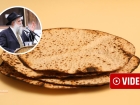Words Cannot Describe The Rebbe’s Face After Tekios
In a special interview, Rabbi Boruch Dov Lesches tells Beis Moshiach about his journey to Chassidus; about the otherworldly atmosphere of Tekios with the Rebbe and about how Moshiach must become our focus so we can succeed in preparing the world for this imminent amazing future • Presented in honor of Rosh Hashanah • By Beis Moshiach Magazine • Full Article
Menachem Ziegelbaum, Beis Moshiach
One of the fascinating personalities in the world of Chabad rabbanus is Rabbi Boruch Dov Lesches. R’ Lesches’ life story includes transitions from and into different worlds. He was born in Tel Aviv and learned in yeshivas Kol Torah in Yerushalayim, one of the flagship Litvishe yeshivos. He was one of the best boys in the yeshiva and was especially dear to the roshei yeshiva, led by the posek, Rabbi Shlomo Zalman Auerbach z’l.
When I asked R’ Lesches about his special relationship with the late posek, he politely demurred.
“The people around at the time said we were very close,” he responded, without elaborating.
There, in the Litvishe world, he was first exposed to the teachings of Chassidus. Together with some of his peers he would sneak out of yeshiva at night and go to the nearby seminar building where they learned Chassidus with Rabbi Yosef Segal.
“The one who shlepped me to these farbrengens was Rabbi Yekusiel Rapp a’h who was also a talmid of the yeshiva and who ran these shiurim. After he switched to Tomchei Tmimim in Kfar Chabad, I took over and ran the shiur together with Rabbi Yaakov Horowitz of Rishon L’Tziyon.”
The shiurim took place at the Bais Yaakov Seminar in Bayit Vegan. “It was a private institution and apparently the principal had a personal issue with the roshei yeshiva and he allowed us to use the place for the shiurim and gave R’ Rapp the keys,” said R’ Lesches with a smile. “We would arrive for the shiur and leave quietly without leaving any fingerprints. The roshei yeshiva knew about the shiur and the silence that shrouded the shiur was good for us and for them.”
Now and then, he would go to farbrengens of the mashpia, R’ Shlomo Chaim Kesselman in Kfar Chabad, which made a tremendous impression on him. R’ Lesches told of a personal, moving story that happened in the time before he was exposed for his Chassidic aspirations:
“It was before I had switched to the yeshiva in Kfar Chabad. I was learning in Kol Torah and with the end of the winter zeman I returned home. The next day, I went to R’ Shlomo Chaim’s farbrengen which was in honor of 2 Nissan. The farbrengen had a special geshmak and lasted till almost morning.
“Due to the late hour, the bachurim suggested I sleep in yeshiva which I did. In the morning, I davened shacharis and went home. When I got there, I began to feel stomach pains but since I didn’t want to tell my parents where I went, I had to suffer in silence. This went on for hours.
“At about four in the afternoon, I felt a little better and went out to daven mincha in a nearby shul. I suddenly noticed two bachurim walking back and forth on my block. I remembered seeing them the night before in Kfar Chabad. The minute they saw me, they came over and said, ‘You’re Lesches? We’ve come on an important mission from R’ Shlomo Chaim.’
“It turns out that I had slept in the bed of a bachur who had gone home the day before because he did not feel well. That morning, they heard that he had a stomach virus and the doctor said to make sure that nobody slept in his bed so they wouldn’t catch what he had. When R’ Shlomo Chaim heard this, he immediately asked whether anyone had slept in that bachur’s bed. They told him that I had slept there. R’ Shlomo Chaim told these two bachurim to go to Tel Aviv and to tell me that if I had stomach pains, it was because I had caught the stomach virus. He warned them not to knock at my door because my parents did not know I had been in Kfar Chabad. They were to walk in front of my house and wait until I came out and then tell me. The bachur asked R’ Shlomo Chaim how long they should wait outside my house and he said, ‘Even a day or two, until he comes out.’ In the end, they had waited only three hours.”
The switch to Tomchei Tmimim in Kfar Chabad happened in 5727 where he became a “mekabel pnimi” of R’ Shlomo Chaim and the Chassidishe atmosphere. Today too, decades later, he often quotes things he heard and absorbed during the long nights of uplifting farbrengens.
“I met with Rabbi Moshe Yehuda Schlesinger, one of the roshei yeshiva of Kol Torah and he was very happy to meet me and I with him. We reminisced and I told him that they get credit for the chinuch for good character traits of some of the finest Lubavitchers. I said that my transferring from Kol Torah to Tomchei Tmimim was a very natural transition for me.”
■ How was the switch from a Litvishe yeshiva to a Chabad yeshiva “natural”?
“This is what I explained to him. You, the roshei yeshiva of Kol Torah, were gifted with straight heads and no arrogance. These traits characterize the bachurim in Tomchei Tmimim and so it was a natural progression. Still, there was a big difference between the yeshiva-learning and learning in the Rebbe’s court. In shiur in yeshiva, the main topic of discussion is the specific sugya in question, whereas when learning the Rebbe’s teachings, all sugyos of Shas are on the table …
“When I said that, he agreed and added that even the greatest opponents of the Rebbe in the Litvishe world agree that the Rebbe’s memory is one-in-a-generation, something that is very rare.”
Just as in yeshivas Kol Torah he was cherished by the roshei yeshiva, in Kfar Chabad too, he enjoyed a very close relationship with R’ Shlomo Chaim:
“When I went to learn in yeshiva in Kfar Chabad, R’ Shlomo Chaim spoke to me about many things in an open, candid way. He once brought up the topic of bachurim who complain that he was mekushar to the Rebbe Rashab and Rebbe Rayatz more than to the Rebbe. In connection with this, he said, ‘They’re right, but my job is to educate them to be mekusharim to the Rebbe as we were mekusharim to the Rebbe Rashab and Rebbe Rayatz and even more so!”
THE REBBE’S TEKIOS
In Nissan 5730, R’ Lesches and his friends went on Kevutza and stayed until after Pesach 5731. He married the daughter of the mashpia, Rabbi Menachem Mendel Morosov in 5732 and continued his learning in Crown Heights for many more years, taking in and absorbing the endless treasures that the Rebbe showered upon him and his friends.
He later settled in Nachalat Har Chabad and along with his learning in a local kollel he worked to spread Chassidus, especially among the younger people.
Over the years, mainly the seventies, he went to the Rebbe many times for Tishrei. He experienced tekios with the Rebbe many times and received lekach and participated in hakafos on Simchas Torah.
■ Can you share with us some “picture” of the tekios from those years that stuck in your memory?
The truth is that it’s hard to describe what we experienced. I once heard R’ Shlomo Chaim explain the Medrash that Hashem gives tzaddikim a taste in this world of a microcosm of Olam Haba. R’ Shlomo Chaim asked: Who, in this world, can know what taste there is in Olam Haba that he can say that he had the privilege of tasting even a microcosm of Olam Haba? He asked and he answered: Tzaddikim have such a pleasure the likes of which they never experienced in this world and therefore, apparently this is a taste of Olam Haba.
That is how we felt by the Rebbe during the tekios. It was a feeling that you cannot compare to anything else that we are familiar with in daily life and therefore, it’s a feeling of a foretaste of Olam Haba. You stand near the Rebbe at the tekios and feel, actually know, that you are in other worlds entirely.
I remember, from the time I was on shlichus in Australia, we got mekuravim to go to the Rebbe. In those days, the trip from Australia to the Rebbe entailed tremendous effort and lots of money, about 2000 Australian dollars and even more. It was a lot of money. Nevertheless, we managed to convince quite a few people to go to the Rebbe.
Before they went, we farbrenged with them and explained what to expect. I would say to them, “You need to know that the Rebbe is the neshama of us all; everyone has his neshama and every neshama has its ‘tune.’ Each of you will experience the Rebbe in a completely different way because it is the most personal experience one can have.”
When they would come back, we would farbreng again and they would give regards from the Rebbe. Each of the mekuravim would start to describe what happened with exactly this point, that each experience is personal and this one’s experience is unlike the other one’s experience. Each one described what he felt.
So often, when I’m asked to describe being at the Rebbe, it’s a feeling that is hard to convey properly. Each time, I would stand with the other bachurim in the front area of 770 at an angle where, of course, we could see the special event of tekias shofar. It would seem that every year it was the same but actually, there were always differences and always a whole new excitement.
There were years when the Rebbe asked that those who had come from behind the Iron Curtain stand near him. We don’t know why; we can just speculate.
When we saw the Rebbe at maftir reading the haftorah with the characteristic tune and intonations, and at the tekios, when we saw the Rebbe’s face when he would fold his tallis back – these were images not of this world. It’s hard to describe.
That was true for the tekios, for Napoleon’s March and at the hakafos. The truth is that when we were at the Rebbe, what we concentrated on was the Rebbe himself and nothing around him.
■ Still, although it’s hard to describe the experience because it’s personal, it’s important to convey to the next generation what you saw and heard.
You’re right!
In one of the sichos, the Rebbe spoke about “Aharon your brother will be your spokesman,” that Aharon’s role was to explain and convey what Moshe said. This is our role, as members of those generations, to convey to the current generation all that we can; it’s our responsibility and obligation to tell everything possible about what it was like at the Rebbe, and to describe it in as much detail as possible so that they can, at least, get a taste of what those days of “a microcosm of Olam Haba” felt like.
The central focus of Rosh Hashana was when the Rebbe began saying the haftorah, followed by the saying of the verses and the tekios – to the moment when the Rebbe would arrive back at his place after the tekios and would uncover and show his face to the congregation, as is customary. It is hard to describe it in words but the light that shone from the Rebbe’s face at that time was otherworldly; something impossible to see any other time of the year.
THE REBBE DEMANDS EVERYTHING FROM US
■ In the Mussar world they put the emphasis on the Day of Judgment. In the Chassidic world, on crowning G-d. What should we, Lubavitcher Chassidim, focus on during the tefillos of Rosh Hashana?
R’ Shlomo Chaim was the mashpia of three generations, by three nesiim: the Rebbe Rashab, the Rebbe Rayatz and our Rebbe. He was able to see things from a broad perspective.
At a farbrengen in yeshiva, he once told us that no Rebbe demanded as much of his Chassidim as our Rebbe. He said that when he learned in Lubavitch, there were baalei Nigleh, baalei Chassidus and baalei avoda. Each went on his own path according to his inclinations and the root of his soul. One worked more on Nigleh and nobody brought up to him the issue of the avodas ha’tefilla that he was lacking. For the ovdim, the emphasis was on the avodas ha’tefilla and they would be less prodded about learning Nigleh, and so on.
In our generation, said R’ Shlomo Chaim, it’s different. The Rebbe wants each of us to be strong in Chassidus, in Nigleh and avodas ha’tefilla. That one should be driven in all directions; that one should do the maximum possible.
When you ask about the point of emphasis for Rosh Hashana, there are details this way and that way, and you need to know what to focus on. But when you see the full range of the Rebbe’s sichos, you see that sometimes he spoke about the need to draw down on Rosh Hashana “Atzmus u’Mehus,” i.e. the very essence of G-d Himself. In other sichos, he spoke about the need, on Rosh Hashana, to daven for material things in daily life.
I can still picture the Rebbe as he said the renowned and amazing sicha about Tefillas Chana who came with a request in the material world. The Rebbe wants a Chassid to deal with all dimensions, all levels, from all aspects and directions. On the one hand to draw down from the highest-of-the-high, but to bring it down into the lowest realms.
Indeed, on Rosh Hashana, which is an all-inclusive day, there is the ability to focus on everything, with the central point being bringing Moshiach to the world.
The Geula is the main point in our avoda in the world. It is our mission; we all need to be enlisted to bring Moshiach. This is the central theme that is woven into all the tefillos of Rosh Hashana, crowning Hashem in the world and the revelation of his kingdom, which will be actualized with the true and complete Geula. The blowing of the shofar is also connected with Moshiach as we know that one of the aspects of tekias shofar is that it alludes to the revelation of Moshiach when the great shofar will sound and those who are lost etc.
■ So we should focus less on the judgment of this day when Hashem sits on his throne of judgment and decides who will live etc.?
Of course, that is also an important part of Rosh Hashana, but the Chassidishe approach is one of “if as children.”
There is the Chassidishe explanation about the blowing of the shofar that it’s like a child who cries, “Father, father,” a cry that comes from the depths of the heart. Then the father hears and responds to his child’s requests.
When a Jew has a deep bond with his Father in heaven, when the Father sees that the child regrets his deeds and commits to improving in the future, the father naturally forgives him for all the negative things and bestows all that is good on him. This is the essential bond that exists between a Jew and Hashem which is like the bond between a father and his child (this refers to those things between man and G-d and not between man and his fellow where he must appease him).
PRESERVING THE UPLIFTING ATMOSPHERE OF ROSH HASHANA
■ One of the big problems of Rosh Hashana in particular and the Yomim Noraim in general is that we make good resolutions when we are inspired and then, when going back to daily life, the good resolutions melt away. How can we preserve them?
That is true for many people. During the tekios or the tefillos people make good resolutions to improve but then forget about it. R’ Shlomo Chaim had a nice saying about this. He gave an example from Simchas Torah when people are inspired to commit to the daily Chitas and they stick to it for a while. R’ Shlomo Chaim would jokingly say that it’s like a birthday farbrengen when the moment comes for the one whose birthday it is to tell everyone the good resolution he is committing to. One of the people gets up and says, “I’ll tell you what your resolution is.”
“How do you know?” wonders the birthday boy.
“You made the same resolution last year, the year before, and the year before that …”
When a person makes a good resolution, he needs to do so seriously, with great thought. For example, if you committed to learning the daily Chitas, you need to do it under any circumstances, no matter what, even if you finished hakafos and you are inebriated and learning Chitas like this will take five hours, you don’t go to bed without finishing it!
Another point, when a person makes a resolution, it need to be specific. It’s not enough to say, “I’ll improve,” or “I’ll be a better Jew.” You need to commit to things like: I’ll say birkas ha’mazon from a siddur; I’ll say the morning brachos with more kavana, etc.
Furthermore, a good resolution needs to follow a progression from light to heavy. That way there is a greater chance that it will happen and continue to be implemented in daily life.
Another idea is that everyone should have a certain time to review the uplifting moments he had on Rosh Hashana or Yom Kippur when he felt inspired and made the resolution. The renewed experience of those moments will keep his resolution “fresh.”
The Gemara says that “divrei Torah need strengthening.” Why is this so when divrei Torah are important and lofty? Because the natural way of things is for a feeling to be fleeting. When a person is fully engaged 24 hours a day, his internal vigor will drive him to also follow through on the thing he committed to as a good resolution.
■ Upon the conclusion of Rosh Hashana, we need to perpetuate the impression of these days, to maintain the atmosphere and good resolutions. How can we do this?
In the presence of the Rebbe, the central spiritual experience of Rosh Hashana was the tekios but that was far from the only thing. During these two days there were also a maamar and sichos at a farbrengen. At the end of the two days was kos shel bracha which went on into the night.
[In general, the kos shel bracha of motzoei Rosh Hashana was the same as the other such occasions around the year, but you could sense in the Rebbe’s expression a different atmosphere, a greater gravity; it was Rosh Hashana’dik.]
You could sense how the Rebbe was “drawing down” the loftiness of these days for a few hours into the weekday, both with the sichos that went on past the time that Yom Tov was over and with kos shel bracha.
In many Chabad communities, like our community in Monsey, it is customary to do this. Many of those who come back from mivtzaim join the seder niggunim and the saying of a maamar and then everyone dances. The balabatim go home long after the Yom Tov is over and at home they know that in shul they are singing the niggunim of the Rebbeim, etc.
There’s no question that this “extension” into the weekdays helps preserve the feeling and holiness of Rosh Hashana for all the rest of the days of the year.
THE CHABAD COMMUNITY IN MONSEY
Rabbi Lesches moved to Australia in 5747 where he was the Rosh Yeshiva of the Yeshiva Gedola in Sydney until 5766. In 5767 he became the rav of the Tzemach Tzedek Chabad community in Monsey, replacing Rabbi Chaim Dovid Nota Wichnin a’h.
There are about 400 Chabad families in Monsey. The connection between the Chabad community and the many other frum Jews in the area is warm and excellent.
“There is a lot of admiration,” says R’ Lesches. We have visitors to the shul from other groups who come for tefillos and farbrengens, especially for the farbrengens of Shabbos Mevorchim and special calendar dates.
“There are no arguments and everyone lives harmoniously together,” says the mara d’asra and he tells of many activities involving spreading the wellsprings that the members of the community do among the broader public.
■ Your familiarity with various frum groups, having started out learning in the Litvishe world, switching to Chabad, and today serving as rav in Monsey which has all types of Jews, no doubt is of help to you.
For sure. In a place like Monsey which has a very high concentration of religious Jews, most of them not Lubavitch, the fact that many know where I come from removes barriers and does away with stigmas. (Smiling): I think that my “stocks” go up by many people when they know that I learned in a Litvishe yeshiva. Many who come with halachic questions know that I’ll give them a detailed answer not only from the world of Chabad psak but also with knowledge of what is done in other places.
■ As a member of the older generation that grew up and was educated by R’ Shlomo Chaim, who was a Jew “from the past,” how do you manage to bridge the generation gap from back then to leading an American community in an age of luxury and indulgence?
That’s a good question and the answer has to do with the core essence of a Jew.
Meaning?
It’s true that that generation lived differently, light years away from our generation, but Jews have one goal that continues from back when until today, and accompanies us throughout without any break: to bring the Shechina down and to prepare the world for Moshiach. The goal didn’t change; perhaps only the method and style did.
I’ll tell you a little story that might make the point more real: My father-in-law, R’ Menachem Mendel Morosov, died at the age of 102. He was an ardent Chassid who really characterized the Chassidim of early times.
When he was about 96-97, he went to Eretz Yisrael and visited there. When he returned to the United States afterward, he related an interesting anecdote. He told me that the roshei yeshiva of Tomchei Tmimim in Ramat Aviv asked him to farbreng with the bachurim. He asked them about the bachurim so he’d know what to say. They told him that they were young, Tel Avivian baalei teshuva who had come to Chabad.
“Do they understand Yiddish?” He didn’t know Hebrew.
“No.”
“So how can I farbreng with them?” he wondered.
They told him, “Come, farbreng. At the very least…”
He showed up at the yeshiva. During the first half hour, when he just began saying l’chaim, no connection developed between him and the bachurim. After half an hour, after a cup and another cup, the bachurim finally began to understand him and he them, and the farbrengen went on for hours.
I don’t know whether it was body language or something else, but that’s what happened.
There is a point where you make yourself battul, and then the differences don’t stand out as much.
Here too, true, I come from the generation of R’ Shlomo Chaim and I’m the rav of a Chabad community in Monsey which is an altogether different style, but when you have a job and a shlichus from the Rebbe, it makes no difference where you are and what you do; you are permeated with the goal and bridge the generation gap. When we work and involve ourselves with what the Rebbe wants us to do, it works in every location and with every demographic.
LIVING WITH MOSHIACH – A CHALLENGE AND A MISSION
■ You mentioned before our avoda to welcome Moshiach and bring down the Shechina. What is the way for every Jew to do his part to bring Moshiach?
Every case is its own question; it depends on who we’re talking about. When a person remembers that this is the main shlichus, he’ll find the way to put it into practice in the appropriate manner.
With that being said, I think that first and foremost, a Chassid needs to be a role model. When a Chassid talks about Moshiach and wants to draw in other people to the matter, whoever hears and looks at him needs to see “that words of truth are recognizable,” and that the Chassid means it with his whole heart and he isn’t just spouting slogans.
■ How can we work on ourselves, to feel Moshiach, for it to be real for us?
That is our mission as it relates to ourselves – to feel and live it for real. To that end, we need to work that it become absorbed within ourselves, to do everything in a manner of toil and exertion, and to really connect to the topic.
They tell about someone who went to the Tzemach Tzedek and said there were things that made him sad. The Tzemach Tzedek told him, “Make sure you are involved with happy things. Think and speak about happy things and that will have an influence on you.”
The same is true for Moshiach. Every Chassid needs to remember our goal which is to bring Moshiach. We need to live it, to think and talk about it, and then there is a chance that we too will live with it and not just pay lip service. It demands work on our part until it becomes internalized. There’s no other option, as this is the main point that needs to drive us.
May this new year be a healthy one and may we merit to welcome Moshiach now!
*
The magazine can be obtained in stores around Crown Heights. To purchase a subscription, please go to: bmoshiach.org
410
Join ChabadInfo's News Roundup and alerts for the HOTTEST Chabad news and updates!










































